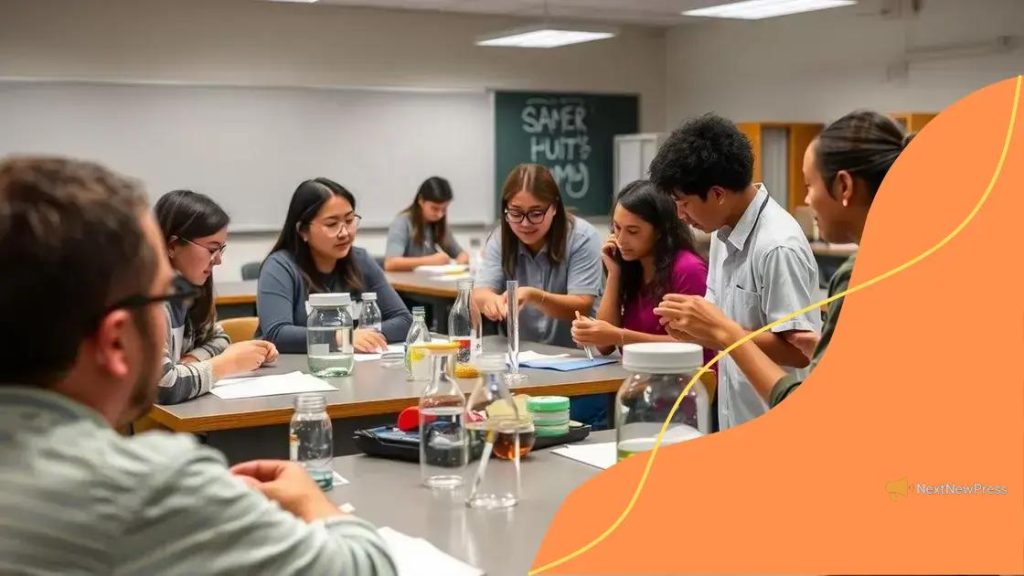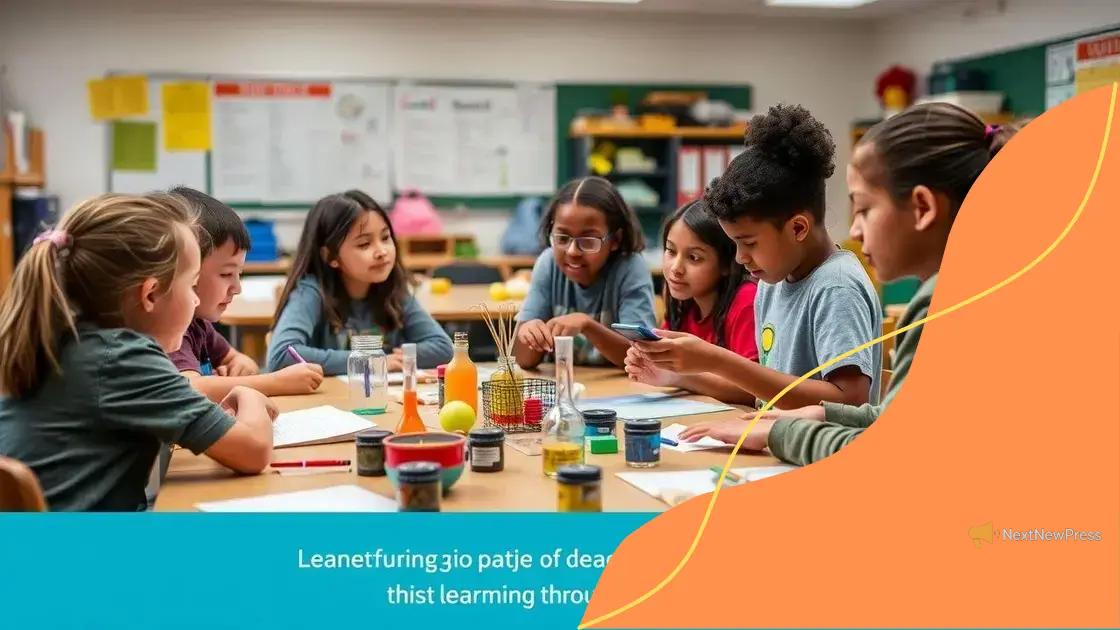Exploring the benefits of inquiry-based learning

Inquiry-based learning actively engages students by encouraging them to ask questions, collaborate on projects, and explore real-world problems, fostering critical thinking and a deeper understanding of concepts.
Exploring the benefits of inquiry-based learning reveals how this teaching method encourages curiosity and critical thinking among students. Ever thought about how engaging learners in their own processes can change outcomes dramatically? Let’s dive in.
Understanding inquiry-based learning
Understanding inquiry-based learning is crucial for educators who want to foster a more engaging classroom. This approach encourages students to ask questions, explore topics, and develop their understanding through active participation.
What is Inquiry-Based Learning?
Inquiry-based learning is a student-centered method that shifts the focus from the teacher to the learners. Instead of passively receiving information, students become active participants in their education.
Key Features of Inquiry-Based Learning
- Student Engagement: Learners are more engaged when they are allowed to explore their interests.
- Critical Thinking: This method promotes a deeper understanding of subjects by encouraging students to analyze and evaluate information.
- Collaboration: Students often work together, which helps them to develop important social skills.
As students delve into subjects that interest them, they become more invested in their own learning journey. This not only enhances their understanding but also motivates them to seek out new knowledge. Teachers facilitate this process by guiding inquiries and providing the necessary resources.
Benefits of Inquiry-Based Learning
The benefits of this approach are numerous. For one, it caters to different learning styles, making education more inclusive. Inquiry-based learning also prepares students for real-world challenges by teaching them to think critically and solve problems creatively. When students take an active role in their learning, retention improves, and they develop a lifelong love for learning.
In short, understanding inquiry-based learning equips educators with the tools to create a more dynamic and responsive classroom environment. By embracing this method, teachers can unlock the potential within their students, paving the way for a brighter future.
Key benefits for students
Understanding the key benefits for students in an inquiry-based learning environment can transform how they engage with their education. This method encourages students to explore, ask questions, and think critically, making learning a more interactive process.
Enhanced Engagement
One of the most significant benefits is the increase in student engagement. When students are involved in their learning, they are more likely to participate and show interest. This process fosters a sense of ownership over their education.
Development of Critical Thinking Skills
Inquiry-based learning promotes critical thinking by encouraging students to evaluate information and consider different perspectives. They learn to ask deeper questions, which leads to a better understanding of subjects.
Improved Problem-Solving Abilities
This educational approach helps students develop problem-solving skills. By tackling real-world problems, they learn to apply their knowledge in practical scenarios. This not only enhances learning but prepares them for future challenges.
- Creative Thinking: Students learn to think creatively as they explore various solutions to questions.
- Collaboration: Working with peers develops teamwork skills, which are essential in academic and career settings.
- Self-Directed Learning: Inquiry-based learning encourages students to take initiative, promoting lifelong learning habits.
These benefits combine to create a richer, more fulfilling learning experience. As students engage in inquiry-based activities, they build confidence in their abilities, which can have a lasting impact on their academic journey.
How inquiry-based learning enhances engagement

Inquiry-based learning greatly enhances student engagement by shifting the focus from the teacher to the learners. This method encourages students to take an active role in their education, which fuels their curiosity and motivation.
Active Participation
In inquiry-based classrooms, students are not mere recipients of information. Instead, they engage actively in discovering knowledge. When learners explore topics that interest them, they are more likely to participate and participate enthusiastically.
Fostering Curiosity
This learning approach stimulates students’ natural curiosity. As they ask questions, seek information, and investigate answers, they develop a deeper relationship with the content. Such curiosity drives them to learn more and think critically about the world around them.
Building Connections
Through collaboration, students form connections with their peers. These connections enhance engagement as learners share ideas, debate concepts, and challenge each other’s thinking. This interaction creates a supportive community that values inquiry.
- Real-World Relevance: Inquiry-based tasks often connect to real-world scenarios, making learning more applicable and exciting.
- Choice and Autonomy: Allowing students to choose their topics fosters independence and responsibility in the learning process.
- Creative Expression: Students engage in various forms of expression, enhancing their creativity and making the learning process enjoyable.
When students feel engaged in their learning, they are more likely to retain information and perform better academically. This sense of ownership makes education a more fulfilling and empowering experience for them.
Strategies for implementing in classrooms
Implementing inquiry-based learning in classrooms involves several effective strategies. These methods can transform the learning environment, making it more engaging and interactive for students.
Create a Question-Driven Classroom
Start by encouraging students to ask questions. A question-driven classroom allows students to explore topics that interest them. Teachers can model the kinds of questions that lead to deeper thinking and investigation.
Incorporate Collaborative Projects
Group work enhances learning through collaboration. Students can work together on projects that require them to investigate answers, debate ideas, and present findings. This teamwork not only increases engagement but also builds essential interpersonal skills.
- Use Real-World Problems: Present challenges that are relevant to students’ lives. This enriches learning by showing the application of knowledge in real-world contexts.
- Provide Resources and Guidance: Equip students with the necessary resources, such as books, articles, and digital tools that support their inquiries.
- Encourage Reflection: Allow time for students to reflect on what they’ve learned and how they’ve approached their inquiries. Reflection promotes deeper understanding.
As students engage in hands-on activities, they become more invested in their learning process. Creating a safe and supportive environment is key to encouraging open dialogue and exploration.
Assessing Progress
Implement formative assessments to gauge student understanding as they work through inquiries. This feedback can guide further instruction and support personalized learning paths, ensuring that all students are progressing in their understanding.
The goal of these strategies is to foster a community of learners who are curious, creative, and engaged in their education. When students are actively involved, they are more likely to retain information and develop a lifelong love for learning.
Measuring the outcomes of inquiry-based learning
Measuring the outcomes of inquiry-based learning is essential to understand its effectiveness in the classroom. By using various assessment methods, educators can gain insight into how well students are grasping concepts and skills.
Types of Assessments
To evaluate students’ learning, teachers can use both formative and summative assessments. Formative assessments occur during the learning process and provide ongoing feedback. Summative assessments, on the other hand, occur at the end of a unit or project to evaluate overall learning.
Focus on Student Growth
When measuring outcomes, it’s important to focus on student growth rather than just final scores. Tracking progress over time can give a clearer picture of student development. Setting individual learning goals helps students understand their journey and achievements.
- Self-Assessment: Encouraging students to reflect on their learning promotes self-awareness and fosters responsibility for their education.
- Peer Assessment: Group evaluations allow students to provide constructive feedback, enhancing collaboration and critical thinking.
- Project-Based Learning Outcomes: Assessing projects that stem from inquiries can show how students apply their learning in practical scenarios.
Testing knowledge through discussions and presentations also gives insight into how well students understand and can articulate their findings. Moreover, it helps build their communication skills, which are vital for future successes.
Using Data for Improvement
Collecting data from assessments helps educators identify trends and areas for improvement. By analyzing this data, teachers can adapt their instructional strategies and provide personalized support to meet students’ needs effectively.
Ultimately, measuring the outcomes of inquiry-based learning is a critical process that ensures students are gaining the skills and knowledge they need to succeed. When assessments are aligned with inquiry goals, the educational experience becomes richer and more meaningful for students.
FAQ – Frequently Asked Questions about Inquiry-Based Learning
What is inquiry-based learning?
Inquiry-based learning is a student-centered approach that encourages learners to ask questions, explore topics, and actively engage in their education.
How does inquiry-based learning enhance student engagement?
It enhances engagement by encouraging active participation, fostering curiosity, and allowing students to explore topics that interest them.
What strategies can teachers use to implement inquiry-based learning?
Teachers can create question-driven classrooms, incorporate collaborative projects, use real-world problems, and provide resources for student exploration.
How can the outcomes of inquiry-based learning be measured?
Outcomes can be measured through formative and summative assessments, self-assessment, peer assessment, and project-based learning evaluations.





